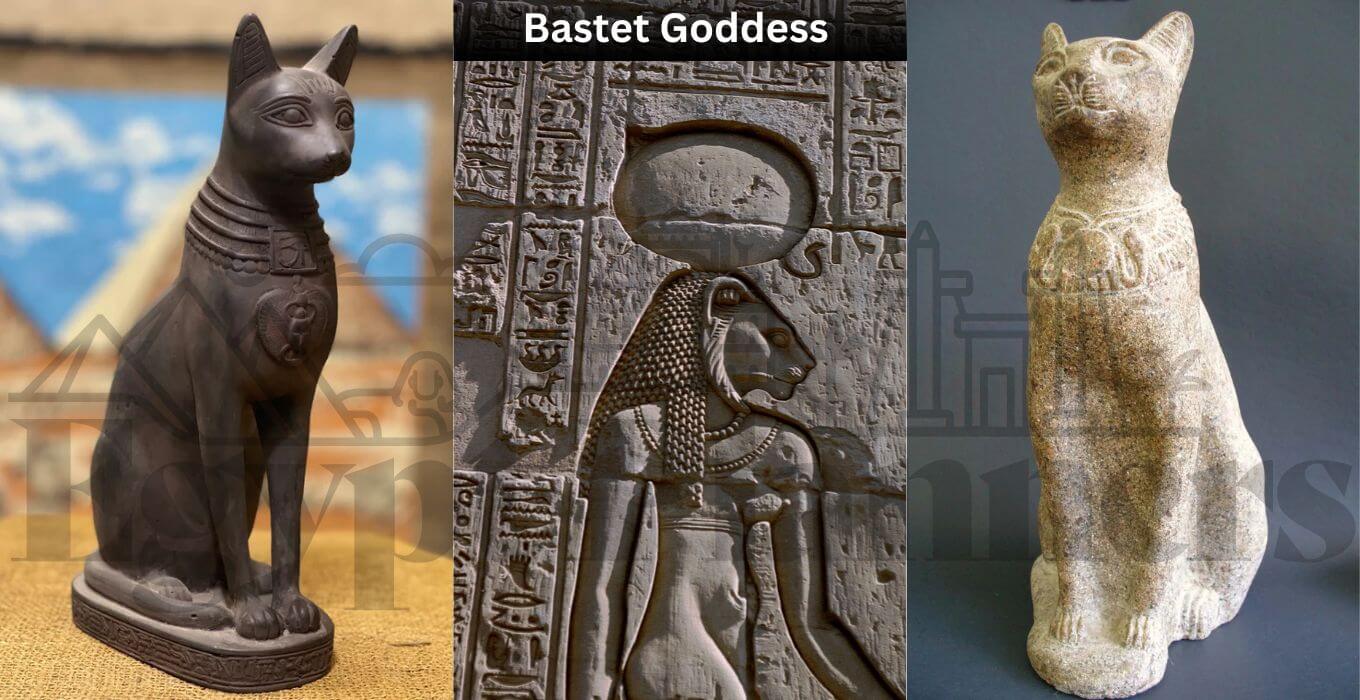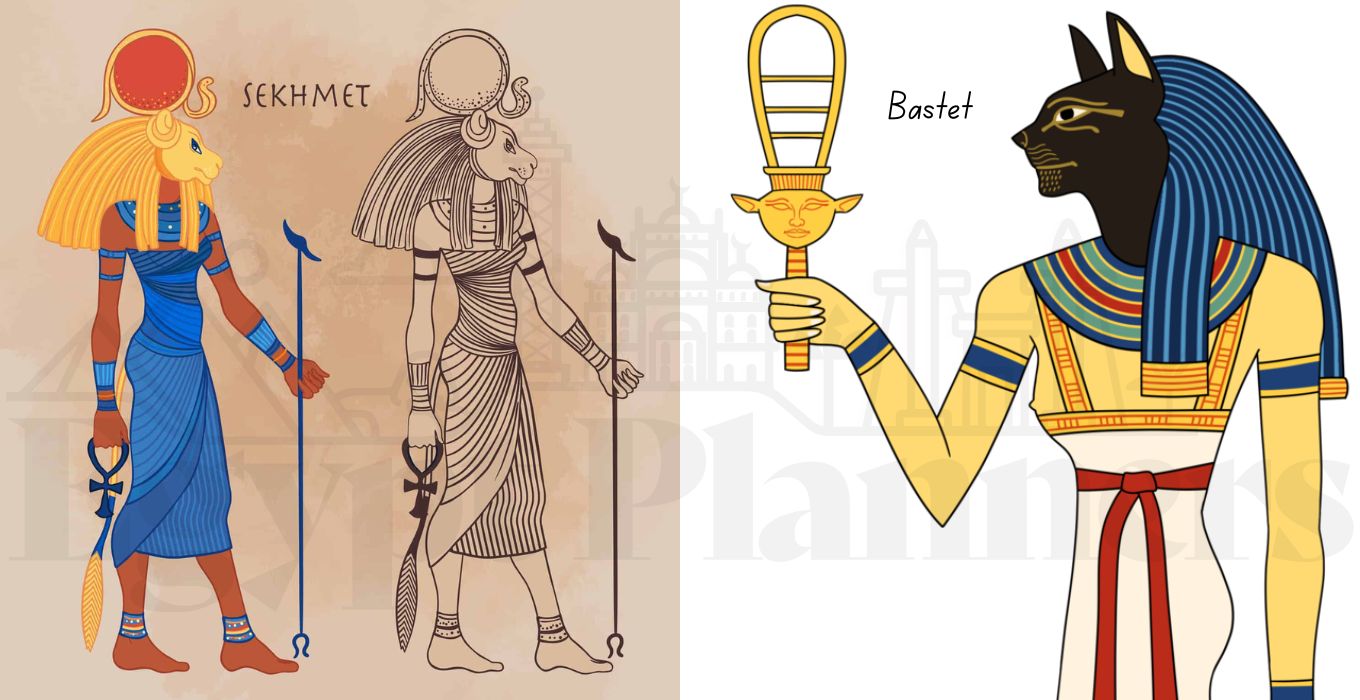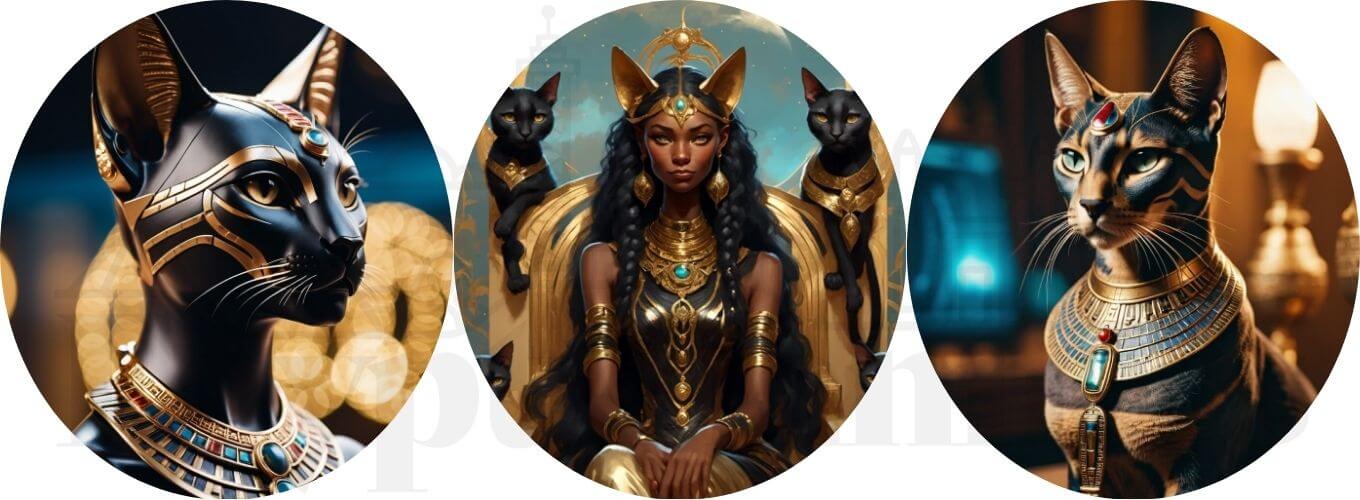Are you ever curious about the myths and legends of the ancient Egyptian goddess Bastet? She is one of the most famous gods and goddesses in ancient Egypt, & she was a highly revered deity in the ancient world. Her story is deeply connected to Egyptian mythology and culture.
What secrets does this Egyptian Cat Goddess hold? How did she capture the imagination of the Egyptians? How did it become one of the most revered animals in ancient Egyptian history? & How was considered one of the most important Ancient Egyptian symbols that we know?
Let’s explore the captivating tales of Bastet, an Egyptian goddess with cat head. We’ll examine her divine origins, transformative nature, and lasting legacy.
You can delve into ancient Egypt by visiting the places that witnessed the construction of this civilization through Ancient Egypt Tours
Key Takeaways
- Bastet was one of the most prominent deities in ancient Egyptian culture, worshipped as the Bastet Goddess of protection, fertility, and home.
- Her representation evolved from a lioness-headed goddess to a more feline, cat-headed deity, reflecting the Egyptians’ deep reverence for cats.
- Bastet’s main cult center was located in the city of Bubastis, where an annual festival attracted thousands of devotees.
- it was associated with other lion-headed like Sekhmet, but she was seen as a more benevolent and peaceful deity over time.
- Cats were highly revered in ancient Egypt for their pest control abilities, which helped protect citizens from diseases and safeguard crops.
Take advantage of our discounted offers with the following All-Inclusive Vacations to Egypt
- 7-Day Cairo with Nile Cruise Tour Package Get -100 USD
- 8 Days Cairo with 3 Nights Nile Cruise by Flight Get 10% Off + Free Activities
- 8 Days Cairo and Nile Cruise Holidays with Abu Simbel Get 7% OFF
- 10-Day Cairo, Alexandria, and Nile Cruise with Abu Simbel by Flight Get 10% OFF
- 12-Day Cairo City & Nile Cruise and Hurghada City
Bastet Goddess Spiritual Meaning: The Feline Deity
In ancient Egyptian mythology, it was a revered feline deity. She was seen as both fierce and gentle. Worshipped since the Second Dynasty (2890 BC), Bastet’s image changed over time.
This change showed the ancient Egyptians’ deep love for cats. They saw cats as important in society.
Bastet’s Dual Nature: Lioness and Cat
She was often shown as a woman with a cat’s head. She carried a sistrum and wore a breastplate. In the beginning, she was like Sekhmet, a fierce protector.
But later, her image became more cat-like. This change showed the Egyptians’ love for cats. They saw cats as protectors of homes and crops.
The Protector of Homes and Sacred Cats
She was a guardian against evil and disease. This made her very important in Egyptian society. Cats were sacred, treated like royalty.
They were given golden jewelry and eaten from their owners’ plates. Mummified animals, including cats, were dedicated to gods like Bastet. This was to gain favor or gratitude.
The cult center of Bastet was in Bubastis, near Zagazig in the Nile Delta. The name means “House of Bastet.” Egyptians saw cats as connected to the sun, because of their fur colors.
Bubastis was famous for its cat mummies. Most were buried in coffins that looked like cats. This honored Bastet and the cats’ sacred nature.

Bastet’s Origins and Evolution
The ancient Egyptian goddess Bastet started in the early dynastic period. She was first seen as a powerful lioness-headed deity. Her first cult center was in Memphis, where she was linked with royal items and protective ointments.
As time went on, Bastet’s influence grew. Her cult spread to the Nile Delta region. Her main worship center was in Bubastis.
Daughter of Ra: Bastet’s Divine Lineage
She was the daughter of the sun god Ra. She was seen as a powerful deity who went with her father across the sky. Her divine lineage made her a key figure in old Egyptian beliefs.
It connected her to the Heliopolitan creation myth and the evolution of Egyptian gods.
From Lioness to Cat: The Transformation of Bastet
Over time, Bastet’s image changed from a fierce lioness to a cat-headed goddess. This change shows the ancient Egyptians’ growing love for domestic cats. Cats were seen as protectors of homes and crops.
The change in Bastet’s image shows the ancient Egyptians’ belief in duality. A deity could have both nurturing and fierce qualities.
Ancient Egyptian Goddess Bastet: Lady of Anointing & Protection
In the history of ancient Egypt, She was a special goddess. She was known for protecting homes and being the goddess of pleasure, fertility, and health. People called her “Lady of the East” and “Goddess of the Rising Sun.”
She was a guardian of both heaven and earth. By day, she helped the sun god Ra on his journey. At night, she became a fierce cat to protect Ra and his followers from darkness.
The Egyptians believed Bastet’s power could keep evil away from homes and families. This made her very important in their lives.
She was also linked to anointing, a sacred ritual in The old. Anointing was seen as a way to connect with the divine and seek blessings. As the “Lady of Anointing,” Bastet was believed to make anointing oils powerful.
| Bastet’s Roles and Attributes | Description |
| Goddess of Protection | Bastet was believed to guard homes, families, and the pharaohs from evil spirits and disease. |
| Goddess of Fertility and Pleasure | She associated with female sexuality, childbirth, and the joys of domestic life. |
| Goddess of Anointing | She was revered for her role in the sacred practice of anointing, which was believed to have transformative powers. |
| Goddess of the Rising Sun | She was seen as a deity who guided the Ra on his celestial journey during the day. |
Worship of Bastet and her cat friends was a big part of ancient Egyptian life. Her fame and lasting impact still fascinate people today, helping us understand Egyptian beliefs and practices.
You can learn more about the Eye of Horus by reading our article: Eye of Horus vs Eye of Ra
The Cult of Bastet and Her Sacred City of Bubastis
She was at the heart of a big cult in Bubastis, in the Nile Delta of Lower Egypt. Her worship in Bubastis started in the 2nd dynasty, around 3000 B.C. It grew over time, especially in the 9th century B.C. during the 22nd dynasty.
The Rise of Bastet’s Popularity in Lower Egypt
Bubastis was a city dedicated to Bastet, the cat. She was worshipped for thousands of years. The 22nd dynasty saw a big rise in Bastet’s popularity, with grand temples built for her.
By the 3rd millennium B.C., Bastet was seen as a fierce lioness in Lower Egypt. The city became very rich and famous. It drew many people for its festivals and rituals each year.
But, over time, It started to decline. She was eventually abandoned after the seventh century due to the Muslim conquest. Yet, the site of Tell Basta, where Bubastis was, has been dug up. It has given us many artifacts and insights into the cult of Bastet and its role in ancient Egyptian mythology and religion.
| Statistic | Value |
| Bastet’s cult dating back to the 2nd dynasty (3rd millennium B.C.) | ~3000 B.C. |
| Peak of Bastet’s popularity during the 22nd dynasty | 9th century B.C. |
| Annual visitors to the Cat Festival in Bubastis | ~700,000 |
| Cats mummified each year during peak reverence | ~10,000 |
| Total cat mummies excavated in various necropolises | Millions |
Bastet’s Relationship with Sekhmet and Other Feline Deities
Bastet and Sekhmet had a complex bond. They were both lion-headed goddesses. Bastet was seen as gentle and nurturing, while Sekhmet was fierce and powerful.
The Duality of Feline Goddesses
As time went on, it became more like a cat. Sekhmet stayed a lioness. This change showed how the Egyptians saw these goddesses differently.
Bastet and Sekhmet were seen as two sides of the same goddess. They showed the Egyptians’ love for the duality of cats. From the calm housecat to the fierce lioness, they were all part of the feline magic.
| Goddess | Attributes | Associations |
| Bastet | Goddess of cats, the sun, fire, love, joy, celebration, fertility, magic, and sex | Protector and guardian of Lower Egypt, daughter of Ra, associated with the “eye of Ra” |
| Sekhmet | Goddess of war, protection of pharaohs, and destruction | Lioness goddess, associated with the sun god Ra, sister of Bastet |
The bond between Bastet and Sekhmet shows their deep meaning in ancient Egyptian myths. They were powerful cat-headed goddesses, full of symbolism.

Myths and Stories of Bastet
The Bastet is deeply woven into the rich tapestry of Egyptian mythology. One of the captivating tales is the “Mythos of the Eye of Ra.” It shows Bastet as the fierce lioness daughter of the Ra. When Bastet gets angry with her father, the god Thoth is tasked with guiding her back to Egypt.
Thoth uses music, dance, and alcohol to calm the angry lioness. This narrative is believed to be connected to the annual Festival of Bastet, held in the sacred city. During this grand celebration, celebrants engaged in ecstatic, orgiastic activities to honor the goddess.
The ancient Greek historian Herodotus described the festival as a joyous occasion. She was filled with music, dancing, and copious amounts of wine. This reflects the fertility and nurturing aspects associated with Bastet.
Bastet’s Role in the Myth of the Eye of Ra
In the “Mythos of the Eye of Ra,” Bastet is portrayed as the powerful daughter of the Ra. She resides as a mighty lioness in the desert. When she becomes furious with her father, the task of guiding her back to Egypt falls upon the god Thoth.
Thoth uses a combination of music, dance, and alcohol to soothe the angry lioness.
The Festival of Bastet at Bubastis
The annual Festival of Bastet, held in the cult center of Bubastis, was a grand celebration. It mirrored the narrative of the “Mythos of the Eye of Ra.” Celebrants engaged in ecstatic, orgiastic festivities to honor the goddess.
According to the ancient Greek historian Herodotus, the festival was a joyous occasion. She was filled with music, dancing, and copious amounts of wine.
| Myths and Stories of Bastet | Key Facts |
| “Mythos of the Eye of Ra” |
|
| Festival of Bastet |
|
Feline Symbolism and Bastet’s Significance
The Bastet symbol holds deep cultural and historical significance in ancient Egyptian mythology, representing the revered goddess Bastet. Known as the goddess of home, fertility, and protection, Bastet was often depicted as a woman with a cat’s head or a domestic cat, symbolizing both ferocity and nurturing care.
The Bastet symbol is closely associated with her protective nature, as she was believed to guard households from evil spirits and illness. For those intrigued by ancient Egyptian history, understanding the Bastet goddess symbol offers insight into the duality of power and tenderness that Bastet embodied.
Cats in Ancient Egyptian Culture and Mythology
Bastet was both a fierce lioness and a gentle cat. This showed how cats were seen in Egyptian stories and life. They were not just useful, but also divine, with Bastet as their protector and symbol of femininity.
- She was loved by many in Egypt, starting from the Second Dynasty. Her temple was in Bubastis.
- This city was a key city in Lower Egypt, where Bastet was worshipped.
- Her fame grew during the 22nd dynasty, around 945 BC.
The importance of feline symbolism in ancient Egypt, Bastet’s goddess significance, and cats in Egyptian culture and mythology is huge. Bastet was seen as a sacred animal, a household protector, and a sign of nurturing in the ancient Egyptian pantheon.
“The Tale of Setna and Taboubu” from Egyptian literature shows Bastet’s role as a guardian of divine order.
The love for Bastet at Bubastis and the mummification of cats as offerings show how much Egyptians valued cats. This highlights the deep respect for felines in ancient Egyptian culture and mythology.
Bastet’s Legacy and Influence
The Bastet still has a big impact today. She is seen as a symbol of protection, and the divine feminine. Her image shows up in art, literature, and in modern Kemetic spiritual practices.
The love for cats and Bastet shows how much the ancient Egyptians valued them. Today, Bastet’s story and image still excite people. They are drawn to the ancient Egyptian myths and their lasting impact on our world.
Bastet in Modern Culture and Artistic Depictions
Bastet’s legacy is seen in many art pieces around the globe. Artists have taken her cat-headed form and made it their own. This shows how timeless and versatile this ancient Egyptian goddess is.
- Bastet’s image is everywhere in jewelry, fashion, and home decor. It shows her lasting appeal as a symbol of femininity, protection, and the divine.
- Today’s artists are inspired by Bastet. They use her image in paintings, sculptures, and mixed media. They explore themes of spirituality, nature, and the bond between humans and animals.
- Bastet also pops up in popular culture. She’s in books, movies, and video games. This makes her even more well-known and loved from ancient Egyptian mythology.
From traditional temple sculptures to modern art, Bastet’s image still fascinates people. It shows the lasting cultural impact of ancient Egypt and its feline deities.
FAQs: Ancient Egyptian Goddess Bastet
What was Bastet the Goddess of?
Why was Bastet Feared?
Was Bastet Good or Bad?
What are Bastet Egyptian Goddess Symbols?
What are Important Bastet Egyptian Goddess Powers?
Conclusion: Ancient Egyptian Goddess Bastet
The ancient Egyptian goddess Bastet is still fascinating today. She started as a lioness but became a cat-headed goddess. This shows how much the Egyptians loved cats.
As Ra’s daughter, Bastet was a strong protector. She kept homes safe, helped with fertility, and kept people healthy. People from all over Egypt went to Bubastis to celebrate her.
Now, Bastet’s story still inspires many. Her image and meaning are found in art, spirituality, and culture. Her legacy lives on, touching hearts and minds.
You can learn more about the history of ancient Egypt through our following article:
- Anubis Egyptian Dog God
- 42 Ancient Egyptian Amulets
- Top 5 Egyptian Symbols for Power
- Top 8 Egyptian Symbols for Strength
- Top 15 Ancient Egyptian Good Luck Symbols
- Top 28 Egyptian Symbols Of Protection
- Revered Animals in Ancient Egypt NYT
- List of 22 Ancient Egyptian Pharaohs
- Egyptian Scarab Beetle Meaning

